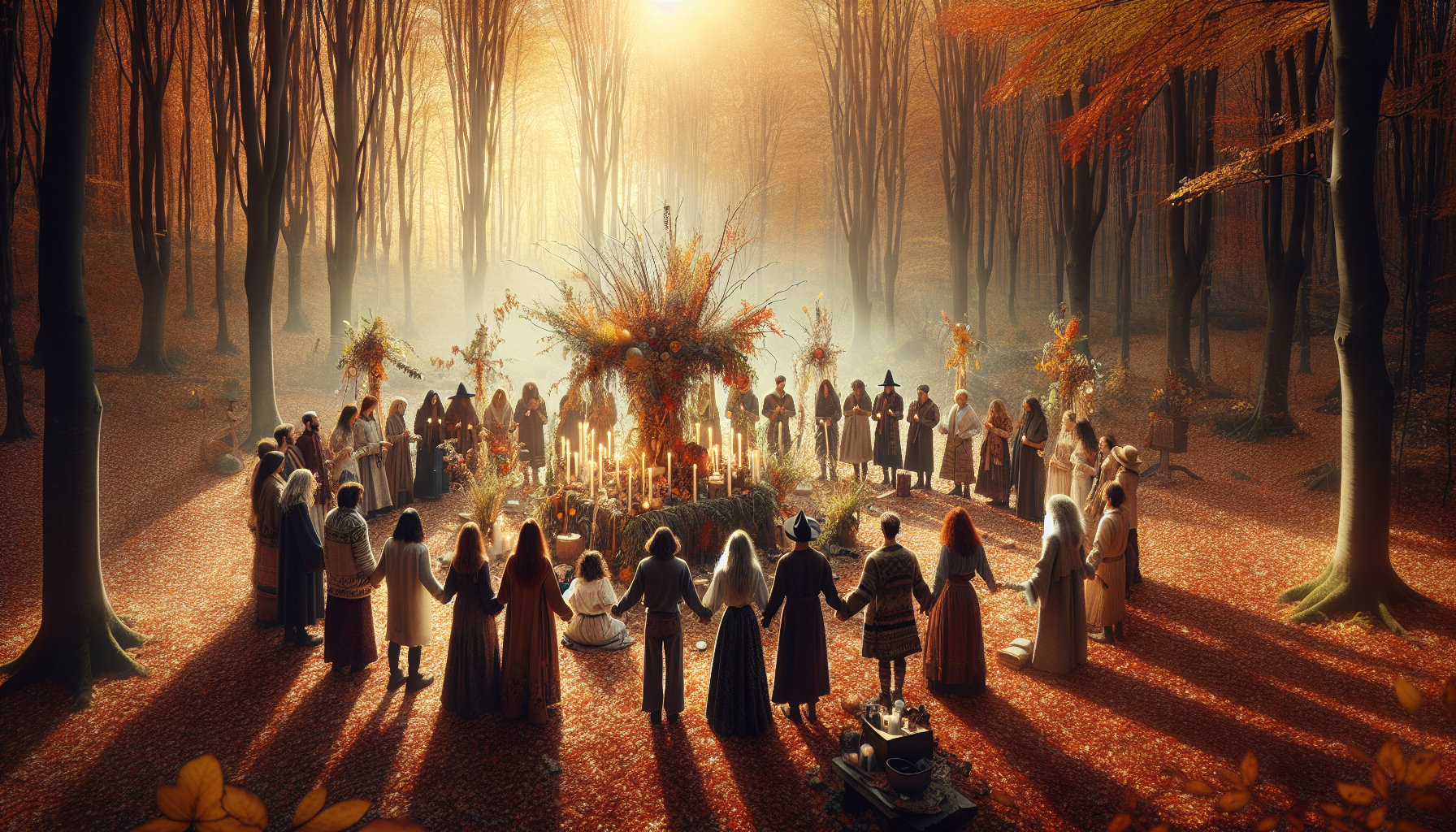As the leaves turn golden and the air grows crisp, there is an undeniable shift that resonates deep within our souls. Nature’s transition from the vibrancy of summer to the quiet dormancy of winter mirrors the cycles of life and loss that we all inevitably face. Yet, amidst this seasonal change, there lies a profound opportunity for reflection, healing, and growth. Welcome to a journey of embracing the healing power of seasonal mourning, where traditions and rituals serve as guiding lights through the dark corridors of grief and renewal. 🍂
In this exploration, we delve into the ancient and enduring practices that have helped countless generations navigate the complex emotions of loss and transformation. From the comforting embrace of communal gatherings to the personal solace found in solitary rituals, we uncover how these traditions not only honor those we have lost but also offer a path to finding peace within ourselves. By examining the ways different cultures and communities approach seasonal mourning, we gain a deeper understanding of the universal need for rituals that provide structure and meaning in times of sorrow.
Throughout this article, we will unravel the layers of seasonal mourning, beginning with an understanding of its historical roots and cultural significance. We’ll explore the psychological benefits of engaging in rituals, shedding light on how they can facilitate healing and emotional resilience. Additionally, we’ll share practical tips and creative ideas for incorporating these traditions into your own life, empowering you to embrace the changing seasons with a renewed sense of purpose and connection. Whether you’re seeking comfort in familiar customs or looking to create your own meaningful practices, this journey will inspire you to honor your emotions and find solace in the cyclical nature of life. 🍁
Understanding Seasonal Mourning
The concept of seasonal mourning is deeply rooted in cultural traditions and personal experiences. It is a process that aligns with the natural cycles of the earth, providing an opportunity to honor losses and embrace healing through rituals and ceremonies. As the seasons change, they bring about a time of reflection, allowing individuals to connect with their emotions and the environment. This alignment with nature can offer comfort and a sense of belonging, facilitating the grieving process.
Seasonal mourning is not a new phenomenon. Throughout history, various cultures have engaged in practices that correlate with seasonal changes. These traditions are often linked to agricultural cycles, religious observances, or historical events. For instance, in many indigenous cultures, the harvest season is a time to honor ancestors and reflect on the cycles of life and death. Similarly, autumn, with its falling leaves and shorter days, often symbolizes a period of letting go and introspection.
In today’s fast-paced world, reconnecting with these ancient practices can provide a meaningful way to process grief and loss. By embracing the rhythms of nature, individuals can find solace and healing, creating a personal sanctuary where they can honor their emotions. Seasonal mourning rituals can vary widely, from simple acts of remembrance to elaborate ceremonies, but all share the common goal of fostering emotional well-being and resilience.
The Role of Rituals in Healing
Rituals play a crucial role in the healing process, offering structure and meaning during times of loss. They provide a framework for expressing emotions, connecting with others, and finding a sense of closure. In the context of seasonal mourning, rituals can be tailored to align with the changing seasons, incorporating elements of nature and personal reflection.
One of the most powerful aspects of rituals is their ability to create a sense of community and support. Participating in a shared ceremony or tradition can help individuals feel less isolated in their grief, fostering a sense of belonging and understanding. This communal aspect is particularly important in cultures where collective mourning is a central part of the grieving process.
Rituals can also serve as a bridge between the past and the present, allowing individuals to honor the memory of loved ones while embracing the future. Whether through lighting candles, planting trees, or creating art, these acts of remembrance can provide a tangible connection to those who have passed, offering comfort and hope.
Creating Personal Rituals
While traditional rituals can be incredibly powerful, creating personal rituals tailored to individual needs and preferences can also be beneficial. Personal rituals allow for a more intimate and personalized grieving process, enabling individuals to honor their emotions in a way that feels authentic and meaningful.
To create a personal ritual, consider the following steps:
- Identify what is most meaningful to you in your mourning process. This could be a specific memory, object, or activity that brings comfort.
- Incorporate elements of nature that resonate with you. This could be as simple as spending time in a favorite outdoor location or incorporating natural elements into your ritual, such as flowers, stones, or water.
- Set aside dedicated time and space for your ritual. Ensure that you have a quiet, peaceful environment where you can focus on your emotions without distractions.
- Consider inviting others to join you, if appropriate. Sharing your ritual with friends or family can provide additional support and create a sense of community.
- Be open to adjusting your ritual as needed. Grief is a dynamic process, and your needs may change over time. Allow your ritual to evolve as necessary to best support your healing journey.
Cultural Perspectives on Seasonal Mourning
Across different cultures, seasonal mourning takes on various forms, each reflecting unique beliefs and traditions. Understanding these diverse perspectives can offer valuable insights into how people around the world cope with loss and find comfort through rituals.
In Japan, the tradition of Obon is a time-honored practice of honoring ancestors. Taking place during the summer, Obon involves lighting lanterns, dancing, and visiting family graves. This festival not only honors the deceased but also reinforces family ties and community bonds. The seasonal aspect of Obon aligns with the natural abundance and warmth of summer, symbolizing the eternal presence of loved ones.
In contrast, the Mexican celebration of Día de los Muertos, or Day of the Dead, occurs in early November, coinciding with the Catholic observance of All Saints’ Day. This vibrant festival is a joyous celebration of life and death, where families create altars adorned with marigolds, candles, and favorite foods of the departed. The timing of Día de los Muertos reflects the autumnal season, a time of harvest and transition, symbolizing the cyclical nature of life.
Similarly, the Hindu festival of Pitru Paksha involves rituals performed to honor and appease ancestors. Held during the lunar month of Bhadrapada, this practice includes offerings of food and water to the deceased. The timing of Pitru Paksha, aligned with the autumn season, reflects a time of harvest and gratitude, emphasizing the connection between the living and the dead.
Modern Adaptations of Traditional Practices
As societies evolve, traditional practices of seasonal mourning are being adapted to fit contemporary lifestyles and beliefs. While maintaining the core elements of ritual and remembrance, modern adaptations often incorporate new forms of expression and technology.
For example, digital memorials and online platforms now provide spaces for individuals to share memories and connect with others in their grief. Virtual candle lighting, video tributes, and social media groups offer new ways to engage in communal mourning, transcending geographical barriers and allowing for global participation.
Additionally, the integration of mindfulness and wellness practices into seasonal mourning rituals is becoming increasingly popular. Activities such as meditation, yoga, and journaling are being incorporated into traditional ceremonies, offering new avenues for healing and self-care. These practices align with the growing emphasis on holistic well-being and personal empowerment in the grieving process.
Embracing Change and Finding Comfort
Embracing change is an integral part of the seasonal mourning process. As the seasons shift, they bring about new opportunities for reflection and growth, encouraging individuals to let go of the past and embrace the present. This acceptance of change can be both challenging and liberating, providing a path to healing and renewal.
Finding comfort in rituals and traditions can provide a sense of stability and continuity during times of upheaval. By anchoring the grieving process in familiar practices, individuals can navigate their emotions with greater ease and confidence. Whether through communal ceremonies or personal rituals, the act of honoring loss and celebrating life can foster resilience and hope.
Practical Applications of Seasonal Mourning
Understanding and embracing the healing power of seasonal mourning can have profound practical applications in everyday life. By integrating these practices into personal and community settings, individuals can foster deeper connections with themselves, others, and the natural world.
In personal settings, seasonal mourning rituals can be incorporated into daily routines to promote emotional well-being and resilience. Simple acts such as lighting a candle at sunset, taking a mindful walk in nature, or journaling about seasonal reflections can provide a consistent anchor for processing emotions and finding peace.
In community settings, seasonal mourning practices can be integrated into public events and gatherings, creating opportunities for collective healing and support. Organizing seasonal festivals, remembrance ceremonies, or community art projects can bring people together to honor shared experiences and foster a sense of unity.
Supporting Others in Their Grief
Supporting others in their grief is an essential aspect of seasonal mourning. By offering empathy, understanding, and companionship, individuals can help create a supportive environment for healing and growth. This support can take many forms, from simply being present and listening to participating in shared rituals and ceremonies.
Encouraging open dialogue about grief and loss can also help destigmatize these experiences and promote a culture of acceptance and understanding. Creating safe spaces for individuals to express their emotions and share their stories can foster connection and healing, both individually and collectively.
Video Resource
To gain a deeper understanding of the healing power of seasonal mourning, watch the video below, which explores various cultural practices and their significance in the grieving process. The video, “The Role of Rituals in Grieving,” is available on the YouTube channel of The School of Life.
Comparative Analysis of Seasonal Mourning Practices
To further explore the diverse approaches to seasonal mourning, consider the following comparative analysis of practices from different cultures. This table provides an overview of key elements and their significance within each tradition.
| Cultural Practice | Season | Key Elements | Significance |
|---|---|---|---|
| Obon (Japan) | Summer | Lanterns, dancing, grave visits | Honoring ancestors, family bonds |
| Día de los Muertos (Mexico) | Autumn | Altars, marigolds, food offerings | Celebration of life and death |
| Pitru Paksha (India) | Autumn | Food offerings, prayers | Gratitude, connection with ancestors |
Understanding these diverse practices can inspire individuals to explore their own cultural traditions and create meaningful rituals that resonate with their personal experiences. Embracing the healing power of seasonal mourning offers a pathway to emotional well-being, connection, and resilience, enriching the human experience through the cycles of life.

Conclusion
Embracing the changing seasons as a metaphor for life’s cycles offers profound insights into our collective and individual journeys through grief and renewal. In this exploration of seasonal mourning, we’ve delved into how nature’s rhythms can guide us through our own emotional landscapes, providing solace and understanding in times of loss. By aligning ourselves with the natural world, we acknowledge the inherent cycles of life, death, and rebirth, embracing the idea that mourning is not just a personal journey but a shared human experience.
Throughout this article, we’ve examined the deep-rooted traditions that cultures worldwide have developed to honor their departed. From the vibrant celebrations of Día de los Muertos in Mexico to the reflective period of Samhain in Celtic traditions, these rituals remind us that mourning is an integral part of the human experience. They serve not only as a means to remember and honor those who have passed but also as communal events that bring people together, providing comfort and solidarity. These traditions, steeped in history and culture, underscore the universal need to process grief in a supportive environment.
Furthermore, we explored the psychological benefits of engaging in mourning rituals. Research indicates that these practices can offer significant emotional relief, allowing individuals to express their grief in a structured and meaningful way. By participating in these ceremonies, individuals often find a sense of closure and a renewed capacity to move forward. This healing power of ritual can transform the mourning process from one of despair to one of hope and acceptance.
Moreover, embracing seasonal mourning encourages us to slow down and reflect, fostering a deeper connection with ourselves and the world around us. In an age dominated by rapid technological advancement and constant connectivity, taking the time to engage with the changing seasons and their associated rituals can be a powerful antidote to the frenetic pace of modern life. It offers us the opportunity to pause, to breathe, and to reconnect with the things that truly matter.
In addition to the cultural and psychological perspectives, we’ve also discussed the role of nature itself in the healing process. Nature’s cycles remind us that nothing is permanent, and just as winter gives way to spring, so too can sorrow transform into joy. By spending time in natural settings, whether through solitary walks in the woods or community gatherings in local parks, we can find comfort and inspiration in the world around us. Nature, in its infinite wisdom, teaches us resilience and the beauty of continual renewal.
The importance of embracing seasonal mourning lies not just in honoring the past but in fostering a hopeful future. By integrating these rituals into our lives, we create a tapestry of remembrance and resilience that honors those who have left us while empowering us to live fully in the present. This connection to the cyclical nature of life encourages us to cherish each moment, knowing that life, in all its beauty and complexity, is fleeting.
As you reflect on the insights shared in this article, I encourage you to consider how you might incorporate elements of seasonal mourning into your own life. Whether by participating in traditional rituals or creating your own personal ceremonies, the act of honoring and remembering can be a transformative and healing experience. Share your thoughts and experiences with others, as discussion and community can further deepen your understanding and appreciation of these practices.
Feel free to comment below on how you have found comfort in nature or tradition during times of grief. Share this article with friends and family who might benefit from exploring these ideas. By spreading awareness and fostering conversations around the power of seasonal mourning, we can collectively enhance our emotional well-being and strengthen our connections to one another.
In conclusion, embracing the healing power of seasonal mourning is an invitation to live more mindfully and compassionately. It is a call to honor the past, celebrate the present, and welcome the future with open hearts. May we all find solace in the cycles of nature and the enduring traditions of our ancestors, drawing strength and comfort from the timeless rituals that unite us all. 🌿🕊️
Toni Santos is a visual storyteller and symbolic naturalist whose creations explore the hidden ecologies and forgotten bonds between humans and nature, as whispered through ancient lore. Through an intuitive and myth-sensitive lens, Toni reveals the sacred choreography between flora, fauna, and human spirit — a world where trees once spoke, rivers remembered, and every herb carried a secret name.
His journey is rooted in the esoteric — in the rituals of forest-dwellers, the botanical codes of shamans, and the unspoken pacts that shaped how ancient peoples lived in deep, reciprocal harmony with the natural world. From sacred groves to serpent-guarded springs, each of Toni’s works reflects a symbolic relationship long obscured by modern forgetfulness.
With a background in visual design and ancestral aesthetics, Toni merges storytelling with sacred ecology. His pieces don’t simply illustrate — they channel. Drawing from myth, mysticism, and lost herbal traditions, he crafts visuals that resonate with the old wisdom: that nature is not background, but kin.
As the creative spirit behind Vizovex, Toni shares collections, visual studies, and articles that illuminate the occulted connections between human life and the wild world. His work calls on us to remember — not just with the mind, but with the senses and the soul — the profound dialogues our ancestors once had with earth, plant, and animal.
His work is a tribute to:
The mythic language of trees, stones, and roots
Forgotten pacts between healers and the wilderness
The sacred knowledge carried in nature’s unseen patterns
Whether you’re a seeker of ancient plant-lore, a mystic attuned to seasonal cycles, or simply someone who hears the forest speak, Toni welcomes you to wander a space where symbolism, nature, and spirit entwine — one myth, one leaf, one vision at a time.




